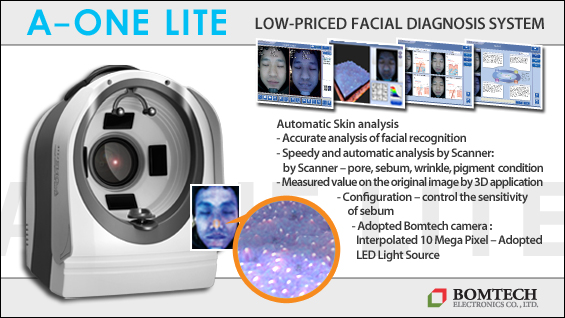▶ Previous Artlcle : #12-1. Revival of IPL and Advent of Radiofrequency and Fractional Photothermolysis
The Advent of Thermage and Fraxel
While multiple devices with little downtime were gaining attention, many people felt skeptical about the diluted effect. Thermage (Thermage Inc.) and Fraxel (Reliant Technologies) entered the scene to fill the gap between the extremely uncomfortable laser deep peeling and extremely simple CoolTouch.
[Advertisement] A-One LITE(Facial Diagnosys System) – Manufacturer: BOMTECH(www.bomtech.net)
Both Thermage and Fraxel seem innovative, but they were the result of a compromise between a certain level of discomfort for consumers and some degree of apparent therapeutic effect for medical service providers. In 2002, the appearance of Thermage that utilizes RF was also a significant change as it allowed manufacturers of skin care devices and doctors to veer away from the difficult use of light as in laser or IPL. Despite it not being a laser, Thermage had comparable effect on skin elasticity and agingSoon, other companies followed suit and released devices that use RF.
Fraxel with moderate discomfort and moderate efficacy was first released in the market based on the concept of fractional photothermolysis proposed by Rox Anderson and Dieter Manstein in 2004. At this time, the overriding sentiment of the market was that unless for a certain disease or indication, laser was no longer necessary for the treatment of various signs of aging. In addition to the initial 1410nm Fraxel re:fine, the introduction of 1550nm re:pair, re:store Dual with 1927nm and CO2Fraxelre:pairshowtheattemptstocontinuouslyenhancetheefficacyofFraxel.Thisfurthercomplicatedtheaesthetictreatmentmarketwithnorulingtrendinthelate2000s.Inacertainaspect,themedicalcommunityaswellasmanufacturersandpatientsevolvedontoamoresophisticatedtreatmentmethod,butchoosingtherightdeviceandtherapyhavebecomemoredifficultfordoctorsandpatients.Besideslaserswithindicationsforskintreatment,lasersforbodycontouringandfatremoval(Smartlipo,CoolLipo,Prolipo,Accusculpt,etc.)haveemergedinthemid2000s.Whenlaserbegantobeusedinskintherapyinthe1980s,thefocusofthedevelopmentwas‘what skin conditions or diseases can laser treat?’ Now the development process has evolved from this question to defining the treatment goal and process first and then finding the right modality. This shift of focus was reflected in the introduction of cryolipolysis (Zeltiq) that uses a cooling system. We are also witnessing the process where different ideas are combined together in a device like Fractional RF, diversifying the range of indications (Syneron’s ePrime, JEISYS’ INTRACEL and LUTRONIC’s INFINI, for example). Since the mid 2000s, existing major laser companies often encountered difficulties in management, while a number of new companies released popular devices. Korea-based manufacturers, like LUTRONIC, LASEROPTEK and JEISYS, etc are successful in the Korean market, elbowing the imported lasers out of the.
It seems likely that skin care devices will become more diverse and complex in the future, and many of them may not be very effective. Doctors will need to improve their knowledge to be able to distinguish the effective ones. The development of aesthetic treatment or laser skin treaynent is influenced by health care system such as the medical insurance, convenience of operation, the cost of devices, patient’s discomfort, therapeutic effect, labor cost for the procedure, and many other factors. In these circumstances, doctors will have to take more caution in determining the treatment costs, type of procedures and the degree of therapeutic effects offered by those procedures.
-To be continued-





















